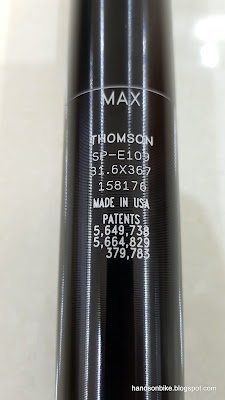A completely new cockpit setup, with new handlebar, shifters, Di2 display and bar tape.
PRO PLT aluminium handlebar, mounted on the previous Controltech 80mm stem.
With the new Deore XT Di2 display, SC-MT800. Shows the selected gear and also the battery level.
Internal cable routing, for the Di2 wire and also the rear brake hose. The rubber grommet of the rear brake hose does not fit into the hole on the frame when fitted around the brake hose.
Thomson Elite seatpost after cutting to the correct length. Di2 battery is hidden inside this seatpost.
Using the same Dura-Ace 7900 5 arm crankset with the same 46T Gates chainring.
Belt tension adjusted with the eccentric bottom bracket
With Alfine Di2 motor unit mounted
Top view of the rear hub area and the Gates CDX carbon drive belt, with a length of 113T.
Maintenance-free drivetrain setup. With belt drive and internal hub, there is no chain or derailleur which will rust when used in wet weather.
Front hub with 12mm E-thru axle. The silver coloured DT Swiss front hub looks a bit out of place here when located next to all the other black components.
View of the DT Swiss ER 1600 Spline DB 32mm front wheel, with the Dura-Ace RT900 disc rotors.
Rear wheel with the same 160mm Dura-Ace RT900 disc rotors and non-series RS805 brake calipers.
View of the full bike! Looks and rides just like a normal road bike, which makes this an all-weather commuting road bike!
Other than the belt drive, the other components look the same as on normal road bikes. Also note the bent seat tube to allow a short chain stay and yet sufficient rear tire clearance.
Using the Canyon Endurace road bike as a reference, I tried to make the setup exactly the same on the Fabike C3, so that these two bikes will feel the same when I ride them. Previously, the Avanti Inc 3 commuting bike was more upright with a different geometry, which made it ride differently from the Canyon Endurace road bike.
The gearing is as shown below, which is the same as on the Avanti Inc 3. With a gear inch of 24 to 99, it is a good range that is more than enough for city commuting.
Gear ratios and range of the Fabike C3.
Using the bottom bracket as a datum for the whole bike, I adjusted the saddle position and handlebar position on the Fabike C3 to follow the Canyon Endurace. Basically, set the same distance from the bottom bracket to the saddle, and likewise to the handlebar.
However, after I set up the Fabike C3, I found that the saddle height and handlebar height is actually higher than the Canyon Endurace. Why is this so, even though I used the bottom bracket as a datum? Both the bikes have a distance of 64.5cm from bottom bracket center to the top of the saddle.
Putting the new Fabike C3 next to the Canyon Endurace, the saddle height is different by about 1 cm.
The shifter position on the Fabike C3 is also higher than the Canyon Endurace, by about 1 cm.
Upon checking again, I found that the bottom bracket height is different on these two bikes. On the Canyon Endurace, the distance from the center of the bottom bracket to the ground is about 27.5cm, while the distance on the Fabike C3 is slightly further at 28.5cm.
In other words, due to the eccentric bottom bracket adjustment, the Fabike C3 has a bottom bracket height that is 1 cm higher. As I used this point as the datum, both the saddle and handlebar position will be 1 cm higher, as what I have measured.
Therefore, these two bikes have the same riding geometry, just the the Fabike C3 is raised by 1 cm overall. This was my intention all along when I got this new Fabike C3 frame, which is to have a commuting bike that has the same geometry and riding feel as the Canyon Endurace road bike.
This bike is not quite all-weather yet, as the SKS mudguards have not yet been installed. That will be shown in the next post where all the accessories will be installed on this bike.



















































